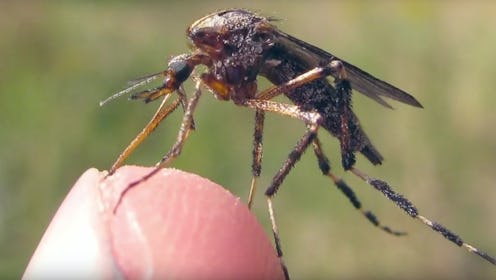Ugh, mosquitoes. These insect vampires feed on human blood and leave your skin covered with itchy red welts, and just when you thought it was safe to go outside again, they're back and bigger than ever. Supersize mosquitoes are here, thanks to Hurricane Michael and Hurricane Florence. Along with devastating winds and torrential rains, hurricanes also spawn what's known as supersize gallinipper mosquitoes. And, this is one supersize option you definitely don't want. According to Mosquito Biologist Michael Reiskind, who wrote about the supersize insects for The Conversation, gallinipper mosquitoes are pretty rare, but the aftermath of hurricanes provides the perfect conditions for them to thrive.
"Their moment in the spotlight comes after major flooding events, like we had with Hurricane Florence," he explained. "Gallinippers have a painful bite that is usually well noticed by human victims, so the large numbers that emerged after Florence have received lots of attention." The good news is that while getting bitten by a supersize mosquito is going to leave a mark, Reiskind said they aren't known to spread pathogens to humans. However, their emergence just in time for Halloween could lead those unaware of the supersize mosquitoes' existence to fear they're living out an insect horror movie IRL, especially if you happen upon a swarm of them.
Picaridin.info, a group dedicated to repelling and controlling mosquitoes, noted that the gallinipper supersize mosquito is the largest in the world, growing up to six times as large as regular mosquitoes. What's more, these giant pests can lay their eggs now and form an egg bank for the next flood at which time they'll hatch and deliver a bite that's equivalent to being bitten by 10 regular-sized mosquitoes.
What makes these supersize mosquitoes such a nuisance is their patience, which means that just when you start to relax, they come to life to unleash their terror. "Eggs are laid in the cracks of dry dirt in areas prone to collecting rain water. They remain dormant over the winter, usually hatching the following year after the first rainfall. Once hatched, the larvae feed voraciously, maturing into adults in a matter of about six days," Picaridin.info explained.
"[Gallinipper mosquitoes deliver] a powerful bite, said to feel like you are being stabbed! The voracious female of the species seeks blood meals day and night, becoming particularly aggressive if her habitat is invaded or disturbed. Due to its large size, the gallinipper can even bite through clothing," the site revealed.
So, if you are in a post-hurricane climate in Florida or North Carolina, and you feel a little stab this Halloween, check for mosquito bites before considering that you've been attacked by a poltergeist. Though, this supersize mosquito is basically the poltergeist of insects. Totally freaked out? Keep in mind that the the silver lining here is that while these supersize bloodsuckers have tested positive for some diseases, there is currently no evidence that gallinipper mosquitoes spread disease to humans or animals.
This means you can't contract Lyme disease from a supersize mosquito. That being said, it doesn't mean encountering a swarm of mosquitoes the size of dimes isn't scary AF. If you're venturing out for Halloween in a post-hurricane area, you might want to choose a costume, perhaps a Wookie, that covers your entire body. If that's not your jam, opt for an indoor party instead.
